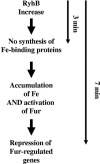Effect of RyhB small RNA on global iron use in Escherichia coli
- PMID: 16199566
- PMCID: PMC1251601
- DOI: 10.1128/JB.187.20.6962-6971.2005
Effect of RyhB small RNA on global iron use in Escherichia coli
Abstract
RyhB is a noncoding RNA regulated by the Fur repressor. It has previously been shown to cause the rapid degradation of a number of mRNAs that encode proteins that utilize iron. Here we examine the effect of ectopic RyhB production on global gene expression by microarray analysis. Many of the previously identified targets were found, as well as other mRNAs encoding iron-binding proteins, bringing the total number of regulated operons to at least 18, encoding 56 genes. The two major operons involved in Fe-S cluster assembly showed different behavior; the isc operon appears to be a direct target of RyhB action, while the suf operon does not. This is consistent with previous findings suggesting that the suf genes but not the isc genes are important for Fe-S cluster synthesis under iron-limiting conditions, presumably for essential iron-binding proteins. In addition, we observed repression of Fur-regulated genes upon RyhB expression, interpreted as due to intracellular iron sparing resulting from reduced synthesis of iron-binding proteins. Our results demonstrate the broad effects of a single noncoding RNA on iron homeostasis.
Figures



Comment in
-
Regulation by iron: RNA rules the rust.J Bacteriol. 2005 Oct;187(20):6870-3. doi: 10.1128/JB.187.20.6870-6873.2005. J Bacteriol. 2005. PMID: 16199555 Free PMC article. Review. No abstract available.
Similar articles
-
RyhB small RNA modulates the free intracellular iron pool and is essential for normal growth during iron limitation in Escherichia coli.Mol Microbiol. 2006 Nov;62(4):1181-90. doi: 10.1111/j.1365-2958.2006.05439.x. Mol Microbiol. 2006. PMID: 17078818
-
A small RNA regulates the expression of genes involved in iron metabolism in Escherichia coli.Proc Natl Acad Sci U S A. 2002 Apr 2;99(7):4620-5. doi: 10.1073/pnas.032066599. Epub 2002 Mar 26. Proc Natl Acad Sci U S A. 2002. PMID: 11917098 Free PMC article.
-
Impact of Anaerobiosis on Expression of the Iron-Responsive Fur and RyhB Regulons.mBio. 2015 Dec 15;6(6):e01947-15. doi: 10.1128/mBio.01947-15. mBio. 2015. PMID: 26670385 Free PMC article.
-
Small RNAs controlling iron metabolism.Curr Opin Microbiol. 2007 Apr;10(2):140-5. doi: 10.1016/j.mib.2007.03.013. Epub 2007 Mar 23. Curr Opin Microbiol. 2007. PMID: 17383226 Review.
-
Interplay between iron homeostasis and virulence: Fur and RyhB as major regulators of bacterial pathogenicity.Vet Microbiol. 2015 Aug 31;179(1-2):2-14. doi: 10.1016/j.vetmic.2015.03.024. Epub 2015 Apr 8. Vet Microbiol. 2015. PMID: 25888312 Review.
Cited by
-
Whole-Cell Biosensor for Iron Monitoring as a Potential Tool for Safeguarding Biodiversity in Polar Marine Environments.Mar Drugs. 2024 Jun 28;22(7):299. doi: 10.3390/md22070299. Mar Drugs. 2024. PMID: 39057408 Free PMC article. Review.
-
Unraveling the interplay between a small RNA and RNase E in bacteria.Nucleic Acids Res. 2024 Aug 27;52(15):8947-8966. doi: 10.1093/nar/gkae621. Nucleic Acids Res. 2024. PMID: 39036964 Free PMC article.
-
Exploring the targetome of IsrR, an iron-regulated sRNA controlling the synthesis of iron-containing proteins in Staphylococcus aureus.Front Microbiol. 2024 Jul 5;15:1439352. doi: 10.3389/fmicb.2024.1439352. eCollection 2024. Front Microbiol. 2024. PMID: 39035440 Free PMC article.
-
The DNA damage response of Escherichia coli, revisited: Differential gene expression after replication inhibition.Proc Natl Acad Sci U S A. 2024 Jul 2;121(27):e2407832121. doi: 10.1073/pnas.2407832121. Epub 2024 Jun 27. Proc Natl Acad Sci U S A. 2024. PMID: 38935560
-
Iron limitation induces motility in uropathogenic E. coli CFT073 partially through action of LpdA.mBio. 2024 Jul 17;15(7):e0104824. doi: 10.1128/mbio.01048-24. Epub 2024 Jun 14. mBio. 2024. PMID: 38874412 Free PMC article.
References
-
- Aiba, H., S. Adhya, and B. de Crombrugghe. 1981. Evidence for two functional gal promoters in intact Escherichia coli cells. J. Biol. Chem. 256:11905-11910. - PubMed
-
- Andrews, S. C., A. K. Robinson, and F. Rodriguez-Quinones. 2003. Bacterial iron homeostasis. FEMS Microbiol. Rev. 27:215-237. - PubMed
-
- Angerer, A., and V. Braun. 1998. Iron regulates transcription of the Escherichia coli ferric citrate transport genes directly and through the transcription initiation proteins. Arch. Microbiol. 169:483-490. - PubMed
-
- Braun, V., S. Mahren, and M. Ogierman. 2003. Regulation of the FecI-type ECF sigma factor by transmembrane signalling. Curr. Opin. Microbiol. 6:173-180. - PubMed
Publication types
MeSH terms
Substances
LinkOut - more resources
Full Text Sources
Other Literature Sources
Medical
Molecular Biology Databases
Miscellaneous


